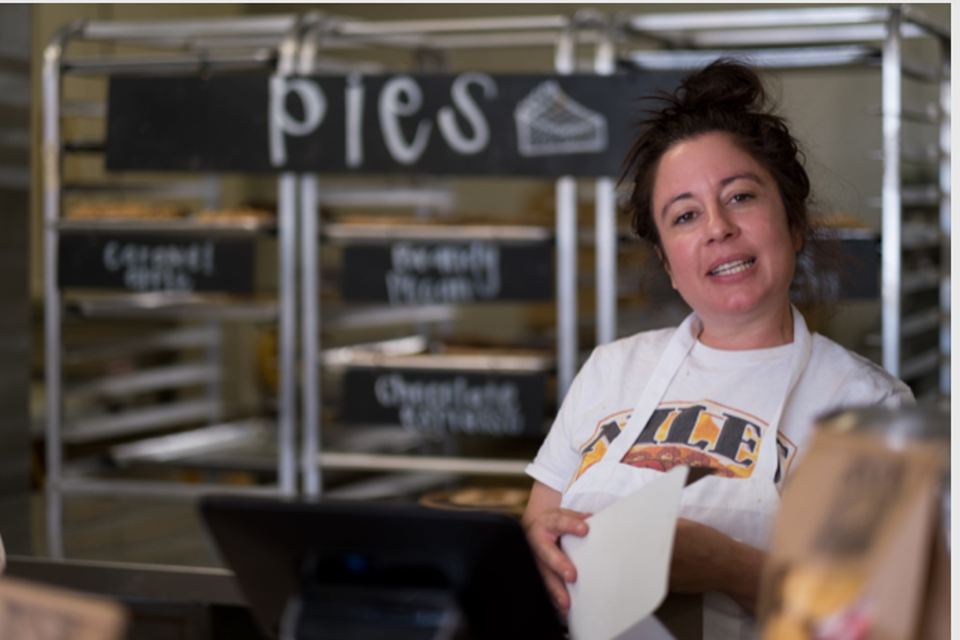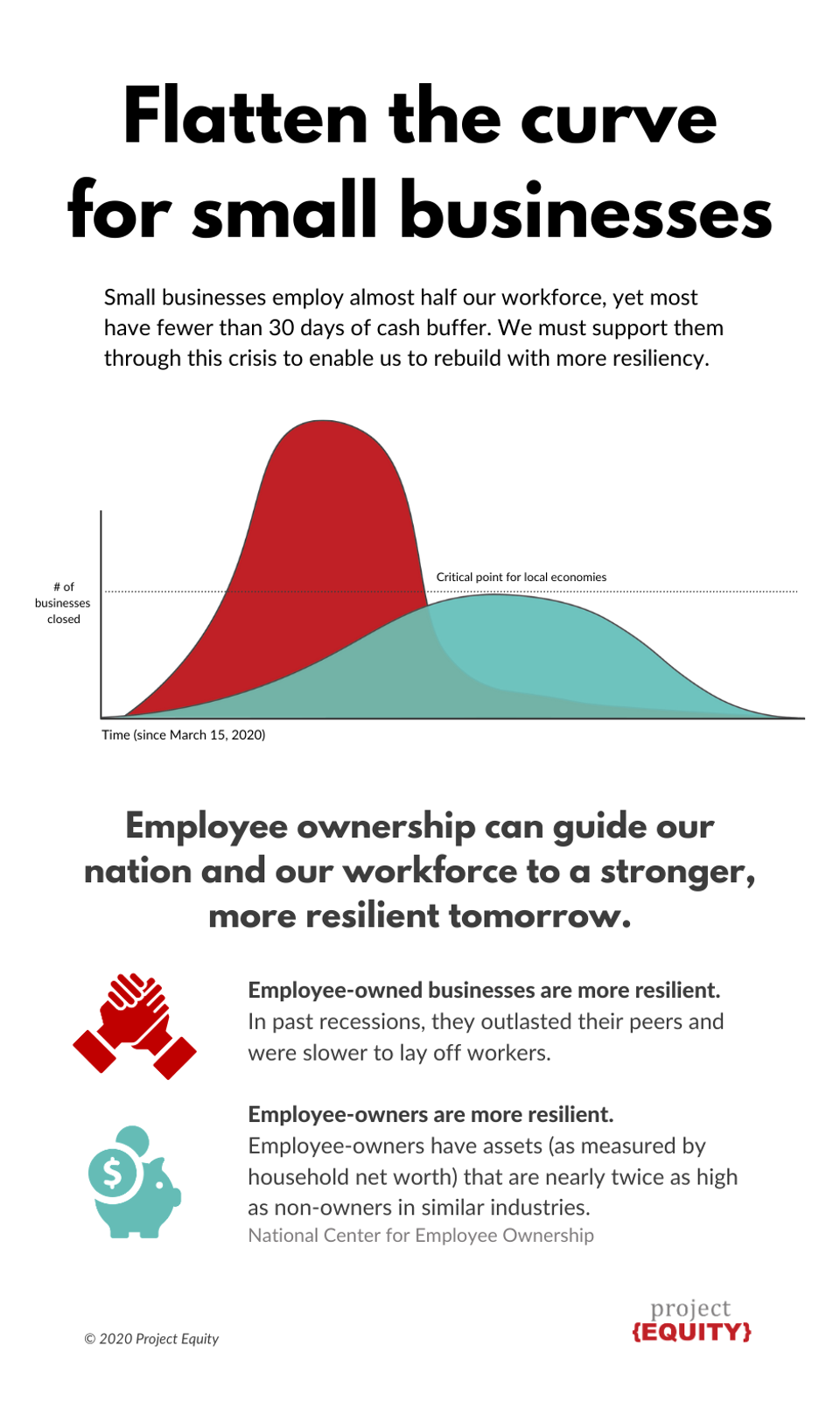Alison Lingane is co-founder of Project Equity, a national leader in the movement to harness employee ownership to maintain thriving local business communities, retain selling owners’ legacies, and address income and wealth inequality. We caught up with her today to get her take on the unprecedented effect the coronavirus pandemic is having on our economy and on our small businesses in particular. Unemployment claims jumped to 3.3 million over the last few days, nearly 5x the highest documented number on record in American history.
Alison, we’re guessing you’re not sleeping a lot this week — are we right?
Yes, I’m afraid so. Our small businesses, local businesses, are struggling to survive. Many suddenly have no money coming in at all. JP Morgan Chase did an important study in 2016 showing that small businesses (500 employees or fewer) have 27 days of cash buffer on average. Those with frontline workers tend to have much less – maybe two or two and a half weeks. So right now, in order to control the spread of the virus, we’re putting businesses and our frontline workers in impossible situations. It’s a new and uncharted kind of crisis.
How do small businesses factor into the overall economic picture?

Project Equity
They contribute nearly half (44%) of the national GDP and employ 47% of the private sector workforce. The scale of the small business health and the impact that has on our economy, on real people’s lives, matches the scale of the issue of public health, of protecting people from dying from the virus. We need to flatten the curve, so to speak, of the financial crisis for America’s small businesses. (See graph below.)
Congress passed a $2 trillion stimulus today — what’s your take?
I’m overall encouraged and it’s important that it happened this week, right now, and that money gets to workers and businesses immediately. But let’s look at this. In the $2 trillion package, there’s about $350 billion to support small businesses to help them weather this crisis. On a very positive note, that includes funding for loans to small businesses that can be forgiven if they are used to retain and keep paying their workers. But do the math: $21.4 trillion was our 2019 GDP and small businesses contribute roughly 44% of that. So $350 billion in potentially forgivable loans equals roughly half a month of the revenue of small businesses as a whole. Now that’s back of the envelope, not counting sick benefits and other things — all to say that the scale of the problem is vast.
How is employee ownership a sturdier structure right now?
The DNA of businesses that are people first is just different, and yes, more resilient. Data from past recessions — including the great recession — show that employee-owned businesses outlast their competitors in business cycle downturns, and that they lay off fewer workers, and rehire them faster. In another part of the world, we see the example of Mondragon Corporation, a $13B cooperative business group in Spain’s Basque region. In 2013, during the Great Recession, their largest manufacturing company went bankrupt. Their response? Repurpose 2,000 employee-owners across their business group of 80,000. Employee-owners came together to take small pay cuts across the board among other strategies to avoid having to lay off big swaths of their employee-owners.

Niles Pie Company is a national employee-owned business that has pivoted quickly in the crisis.
Project Equity
The other thing about employee-owned businesses is the personal safety net for employee-owners. We’re all familiar with the study that shows that the average American doesn’t have $400 for an emergency expense. Employee-owners have significantly higher assets—nearly twice as high on average as their peers in non-employee owned businesses based on a study by the National Center for Employee Ownership. We also see profit-sharing creating meaningful impacts for workers. As one example, at Niles Pie Company, a business that Project Equity helped to transition to employee ownership, profit-sharing was the equivalent of $4.50 per hour. It’s game changing when you think about resiliency, when you think about a crisis, to actually have personal and family assets to fall back on.
What can consumers do right now?
Think about how you’re spending your money and try to spend as much of it as you can with locally owned businesses. I have a friend who wants to make sure the produce market that’s two blocks from her house doesn’t go under and she’s also concerned about going into the store. So she called them and they are totally open to having her text the order and they’ll bring it out to her car. You can order takeout or delivery to support local restaurants, purchase gift cards from local stores or restaurants, order produce boxes from area farms or farm distribution networks, donate to a specific fund for supporting workers or local businesses. So, there’s lots of ways and I just encourage people to just stop and think: how do I make sure what money I spend goes to locally owned businesses? This is always important and absolutely critical now.
What looks different after the pandemic?
We’re at a juncture. It’s about us as a society making a choice about how are going to rebuild — and I’m choosing that word “rebuild” because I do think that’s what it will be. How do we avoid further wealth concentration that makes us less stable for the next crisis — be it a pandemic or something else we can’t see coming.
At Project Equity, we’re working with our partners to support employee ownership transitions, including providing capital to do so. That’s a strong path to economic resiliency — not to mention equity — and it absolutely must be in our playbook as a country if we want to come out of this stronger than before.

Project Equity
The article was origianlly posted at: %xml_tags[post_author]% %author_name% Source%post_title%
